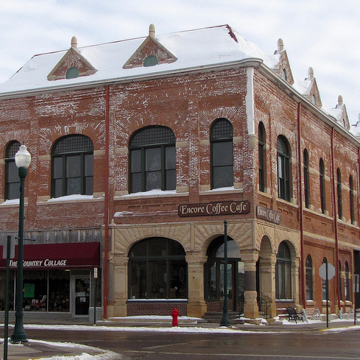You are here
Grand Opera House
From its completion in 1892 until 1921, the Grand Opera House in St. James served as the southwestern Minnesota city’s main source of entertainment. Traveling companies performed theatrical, musical, and comedy productions while local groups hosted events including plays, basketball games, organizational meetings, and concerts by local bands.
Hundreds of opera houses were built throughout the Midwest between 1880 and 1910. The growth of the railroad after the Civil War cut transportation costs and made it practical for theater troupes, vaudeville acts, and opera companies to reach small towns across the country. For immigrants settling in the Midwest, the erection of an opera house was a link to their past, as many of their hometowns had theaters and opera houses, but it was also a sign of prestige and culture on the frontier amidst the farms and prairies. St. James, platted in 1870 by the St. Paul and Sioux City Railroad, became a division headquarters for the railway company, was named the county seat in 1878, and had a thriving agricultural output that brought 100 businesses to the town by 1896.
Like most small town Midwestern opera houses, the building had its auditorium on the upper floor and the ground floor was used for retail in order to generate revenue through its four commercial units. Local builder John S. Bumby constructed the building to designs of unknown origin. The structure measures 100 feet long by 50 feet wide and its brick walls rise off a stone foundation over a full basement. A mansard roof is clad with pressed metal sheets designed to simulate slate tiles. Its Queen Anne design reveals itself not only with its brick and Kasota limestone dormer windows breaking the roof line, but also through the variety of brick laying, as well as its many pediments, finials, springing blocks, and pilasters. The opera house auditorium, located on the second floor, originally held 392 attendees in addition to a stage on the north end and dressing rooms. The curvilinear balcony seated an additional 250 when completed and also contined small rooms for technical elements and storage.
The growth of the movie industry in the 1920s led to the demise of many opera houses and St. James closed the upstairs of its building to the public in the 1950s. At that time the grand staircase to the second floor was destroyed. Local citizens established a nonprofit preservation organization in an effort to raise the funds to restore the second floor, including returning the stage, for use as a community center and to stage other events.
References
Granger, Susan, Scott Kelly, and Kay Grossman, “Grand Opera House,” Watonwan County, Minnesota. National Register of Historic Places Registration Form, 1997. National Park Service, U.S. Department of the Interior, Washington, D.C.
Knudson, Shirley R., ed. History of Watonwan County Minnesota. Dallas: Curtis Media, 1995.
Satterthwaite, Ann. Local Glories: Opera Houses on Main Street. Where Art and Community Meet.New York: Oxford University Press, 2016.
Writing Credits
If SAH Archipedia has been useful to you, please consider supporting it.
SAH Archipedia tells the story of the United States through its buildings, landscapes, and cities. This freely available resource empowers the public with authoritative knowledge that deepens their understanding and appreciation of the built environment. But the Society of Architectural Historians, which created SAH Archipedia with University of Virginia Press, needs your support to maintain the high-caliber research, writing, photography, cartography, editing, design, and programming that make SAH Archipedia a trusted online resource available to all who value the history of place, heritage tourism, and learning.





